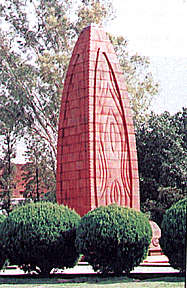
INTRODUCTION
Amritsar is the most sacred city for the world's 16 million Sikhs. It lies in the state of Punjab in the north-west India, where Sikhism was born. The city rests on a large, flat plain which reaches across into Pakistan to the north, where it rises into the Himalaya and Karakoram mountains. Five rivers cut across the fertile land. They give both the area and the state the name Punjab, for in the Panjabi language, 'panj' means 'five', and in the Persian,' ab' means 'water'. Panjabi is the language spoken by mostly all Punjabis, but an old form of Punjabi is used in the holy scriptures, which is called 'Gurmukhi'.
The most striking image of Amrtisar is its enormous pool, with the magnificent Golden Temple adorning in the centre. The name Amritsar means 'pool of necter', and its waters are said to bring immortality and relief from illnesses to those who bathe in them. But it is only these sacred waters that make the city special for Sikhs. For inside the Golden Temple lies the collection of Sikh holy scriptures known as the Guru Granth Sahib.
Amritsar was built as a holy city during the 1570's by Guru Ram Das, the fourth Guru. Since then Amritsar has undergone many changes and has been demolished and rebuilt several times. Today it is a lively, modern city and although Sikhs do not have to go on pilgrimage, they come from all over the world to visit the Golden Temple and many other shrines, and to walk around the sacred pool on patterened marble pavements - to pay their humble homage to their Satgurus.
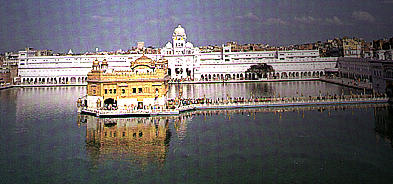
Between 1526 and 1858, while India was under Muslim rule, the Sikh Gurus established many towns, including Amritsar. One tradition says that the Muslim ruler, Emperor Akbar, gave the land on which Amritsar was built to the third Guru, Amar Das. No one knows if this is true but it was certainly Amar Das who established the site of Amritsar, close to a natural pool that was said to contain healing waters.
The pool of miracles There are many Sikh legends and traditions linked with the site of Amritsar and especially with the pool. It is said that there was always an amritkund, a reservoir of the nectar of immortality, where Amritsar now stands.
Stories of these waters are told not only in Sikh tradition but also in the traditions of other Indian religions. The story of Bibi Rajni lends quite an importance to this pool. Briefly it is said that her husband who was a leper fell into the pool and was cured of all illnesses. It is also said that Lord Rama, and his sons fought at the holy site of Amritsar. Rama was killed and then miraculously healed when he was given the amrit (nectar) to drink. Some people say that the Lord Buddha, founder of the Buddhist religion, also visited the pool. But Sikhs believe that Guru Amar Das cured the second Guru, Angad, of a skin disease by using a herb that grew near the pond. The site of Amritsar was certainly very special to people of many different faiths.
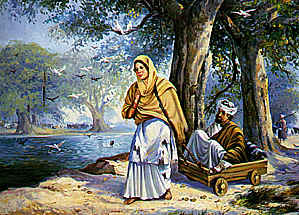
Who will build the holy city? Guru Amar Das did not build Amritsar himself. This was left to his son-in-law, the fourth Guru, Ram Das. It is said that Guru Amar Das tested Ram Das and another son-in-law to see which one of them would be the most worthy Guru to follow after him. The Guru challenged each man to build a raised platform, to see which was the best. After the platforms had been completed, the Guru then told his sons-in-law that the platforms were not good enough. He ordered the two men to pull them down. The other son-in-law became very angry and refused to do as he was asked, but Ram Das knocked down his own platform without protest. Ram Das was tested even further. He had to rebuild the platform seven times before the Guru was satisfied
Ram Das makes the pools From building seven platforms, Ram Das went on to build the holy city of Amritsar. He developed the site with the help of a group of elderly and well respected Sikhs. First, the Guru had a new pool excavated. This pool was called Santokhsar, after a Sikh follower called Santokha of Peshawar. Santokh means 'contentment'. But before the pool was even finished and paved, the Guru asked Ram Das to build another pool on low-lying ground to the east of the first one. This was to be the Amritsar, the pool of nectar that gives immortality. A jujube tree called Dukhbhanjani Ber marked the spot where the pool was to be made. It is still there today. Labourers were hired to dig the pool but many Sikh followers helped out. As the pool progressed, traders and businessmen were drawn to the settlement to serve the workmen's needs. Wells were dug, homes were built and markets were set up. A small town was beginning to grow. Guru Amar Das died in 1574. Ram Das became the fourth Guru and completed the pools in 1577.
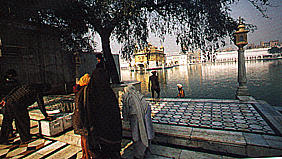
The temple in the pool In 1581, Arjan became Guru and decided to have the holy pool lined with bricks. A temple was to be built in the middle of it. Guru Arjan himself designed it, and he also laid the foundation stone. (Another version is that the foundation stone was laid by Mian Mir, the Muslim fakir, but after considerable study, I think the former statement seems correct - a book written on the Golden Temple by Giani Kirpal Singh, the head Granthi of Harmandir Sahib for a number of years, and an eminent scholar has written thus after researching the subject intensively.)
It is now known throughout the world as the Golden Temple. But Sikhs call it Darbar Sahib, the Lord's Court, or Harmandir Sahib, God's Temple.
The Akal Takht Under Guru Arjan, Amritsar grew and prospered. New houses were built and bathing pools and gardens were laid out. But Guru Arjan's life ended tragically. There were problems with the Muslim emperor, Jehangir, and the Guru was martyred in Lahore in 1606. The death of Guru Arjan changed Sikhism in Amritsar. The sixth Guru was Guru Arjan's son, Hargobind. He now felt the need to defend the faith and build a strong Sikh community. Guru Hargobind wore two swords: one represented his spiritual power and the other his worldly authority. He was not only a holy man as the other Gurus had been; he was also a prince. This change in Sikhism led to new developments in Amritsar. A raised platform with a building on top was put up about 80 metres from the Harmandir. It was called the Akal Takht, the Throne of the Timeless One. Inside the new building, Guru Hargobind set up a court of justice and a team of administrators. Decisions and orders were sent out to the community from the Akal Takht, as they still are today. But the strength of Guru Hargobind led to conflict with the Muslim rulers, so he moved away from Amritsar. Guru Hargobind was the last Guru to have direct links with Amritsar; the next four Gurus lived elsewhere.
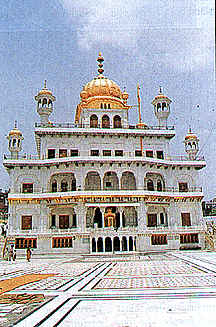
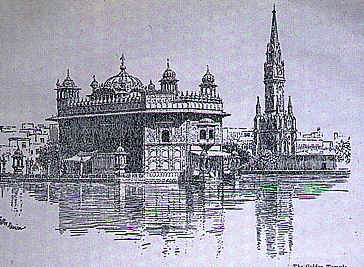
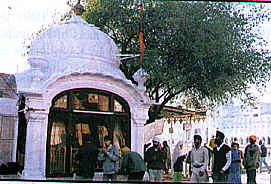
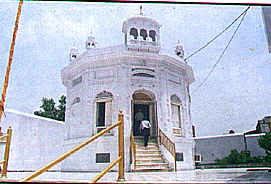
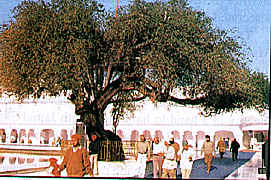
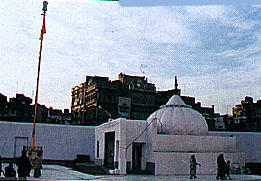
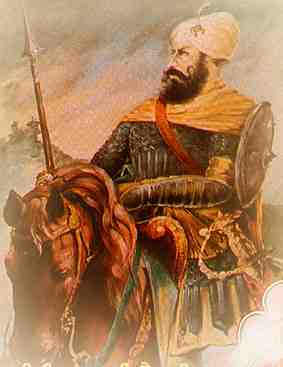
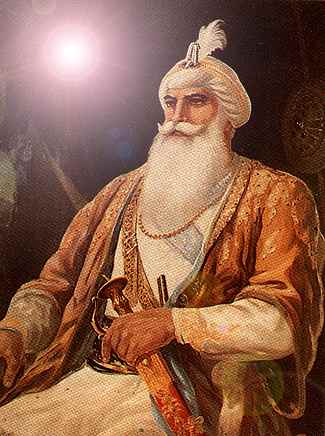
The growth of Amritsar After many troubles, Amritsar slowly developed. 1776 had completed the pool, the Harmandir, the bridge and the gate, known as the Darshani Darwaza. Other shrines were built around the pool.
The different groups of Sikhs built homes in Amritsar and put up their own small forts surrounded by defensive walls. These areas were called katras. Each one was named after its founder. Nowadays, a katra is a residential area with a market. katras are special to Amritsar; other towns do not have them.
In 1794, Jassa Singh Ramgarhia built a large residence called a bunga, near the Harmandir. It is a fine old building with two towers, which rise to 46 metres There were originally four bungas planned but only two were completed.
Jassa Singh had conquered territory as far afield as Delhi, where he removed the slab from the throne on which the Mughal coronation ceremonies were held. He brought the slab to Amritsar and placed it in the Ramgarhia Bunga where it still lies.
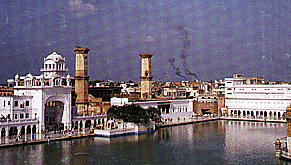
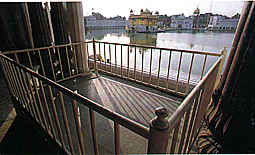
The bungas were originally used by Sikhs to prepare themselves for attacks on their city. But as the invasions stopped and Sikh power grew, the bungas and residences became more like royal courts. There was plenty of room for visitors and pilgrims to stay. Each misl had its own bunga, and many rich and important people began to build them. Gradually, each community within the city had one of its own. There are said to have been more than 70 bungas by the early 19th century. Apart from the Ramgarhia Bunga, all of them have now been pulled down to make way for modern buildings.
The old bungas were important centres of learning and art. They attracted scholars, writers, artists, musicians, doctors and calligraphers. Historians and theologians studied beside the pool and the temple. It was like a great university.
During the 20th century, the land on which the bungas were built was bought by the Shiromani Gurdwara Prabandhak Committee, which controls Sikh affairs. The bungas were demolished and the centre of learning vanished. Frescoes and other decorations were destroyed. The land was used to widen the parakrama, the pathway around the pool. A new meeting hall was built, a hospital, some hostels and offices, and a Guru's kitchen, where meals are prepared for worshippers

Ranjit Singh, the great builder
Maharaja Ranjit Singh was a great Sikh emperor who ruled in the Panjab between 1799 and 1839. He developed Amritsar more than anyone else. Largely he as it is today built Amritsar. In 1799, Ranjit Singh seized Lahore, then the capital of the Panjab. Soon after, he took Amritsar, which was still just a collection of katras and bungas. Each one was ruled by a different family (misl), which kept its own defense force and employed its own tax collectors.
When Ranjit Singh took over the city he united it, demolished the small forts and built a massive city wall. It is said to have been 20 metres wide and 6 metres high, with a large moat all around it. There were 12 gates leading into the city. When the wall was finished, Ranjit Singh rode in triumph through Amritsar on an elephant, showering coins on the cheering crowds. He bathed in the sacred pool and gave money to have the Harmandir rebuilt in marble and covered in gold. The Harmandir then became known as the Golden Temple.
During Ranjit Singh's rule many more people built bungas, which were decorated with murals and mirror work. Some of them were very tall. A commercial centre grew, with markets for rice, dyes and fabrics, and for ironworkers and saddlers. There were gardens and open spaces all within the city wall. Carpenters, blacksmiths, ivory carvers, potters, shoemakers, weavers, goldsmiths, leatherworkers, dyers and gunsmiths all traded in the city. Clothmakers wove Pashmina shawls, which are made of a special kind of wool. Shoemakers sewed jootis - the richly embroidered shoes with curled toes. Metal crafts were very highly developed and Ranjit Singh had coins minted in the names of the Gurus.
Ranjit Singh's own palace was called the Rambagh. It was set in a beautiful garden, which was laid out in 1819. Gardening was a great hobby with wealthy people in India. The design of Ranjit Singh's garden was greatly influenced by the Muslim Shalimar Gardens in Lahore. But there was a big wall and a moat around Ranjit Singh's, with ramparts and a gate with spaces for guns in it. In the centre, a palace with a cool underground chamber was built. A double row of fountains crossed the garden. The majestic palace showed the strength of Ranjit Singh's influence in Amritsar.
The British in Amritsar Amritsar developed well during the rule of Ranjit Singh, but after he died there was no one else who was as strong and as capable as he was. The kingdom fell apart.
During the early 19th century, the British had gradually gained power in India to protect their trade in Asia. They had been trading in India since 1600. Panjab was the last territory which they took, in 1849. The British built government offices, roads and railways, so that law and order could be maintained and trade could carry on peacefully. They also made irrigation channels, which meant that more fields could be cultivated. Panjab grew richer. In Amritsar, the British built law courts, a hospital, a railway station. A town hall and district offices.
(Extracts and information by courtesy of books by Beryl Dhanjal and Harpreet Singh)
A tall tower rises above most other buildings in Amritsar. It is called Baba Atal and is named after Baba Atal Rai, who was the son of Guru Hargobind. Atal Rai died when he was only nine years of age, and this building reminds Sikhs of his story. It is said that before his death, one of his playmates had died, but Atal Rai did not believe his playmates and said that the boy was faking his death to avail himself from his turn while playing hide and seek. Thus he ordered the boy 'Mohan' to rise and continue with the game.The dead boy arose and they continued playing - But this news reached Guru Hargobind and he was annoyed at his son, as showing of miracles is not encouraged in Sikhism. In repentence Baba Atal Rai immediately lay down and gave his life. The nine floors of the tower denote his nine years of age.
It is said that Baba Atal used to supply langar to the Sikhs. His service and devotion led to saying "Baba Atal -Pakikian Pakkaiyan ghal !" (Baba Atal - supply prepared meals)
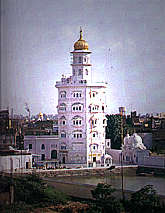
A Saga of Sacrifice
"Na vakil, na appeal, na daleel," this is how the Indian people, more particularly the Punjabis, denounced the Rowlatt Act which, from all accounts, was the root-cause of the unrest that led to the ignoble massacre of Jallianwala Bagh.
The Rowaltt Act, which came into operation on March 21, 1919 was designed to replace the draconian Defense of India Act which was due to lapse on account of the termination of the hostilities at the conclusion of World War-I. It provided special courts for whose judgements there could be no appeal. Trials were to be held in camera and consideration of evidence was not admissible. The provincial governments were delegated extra-ordinary powers to search, arrest and demand security among other things. The irony was that all these repressive measures were inflicted immediately after the remarkable contribution made by the Indian soldiers enabling the British to win the War. It was a move against the British Government's professed aim to prepare India for self-rule and President Wilson's much-trumpeted 14-point Charter promising the right of self-determination for all people after the War.
By imposing the Black Act, as the Rowlatt Act was generally called, the British and Anglo-Indians and Pro-British majority posed a challenge to the Indians. Indians had no alternative but to accept this challenge to their national pride and political aspirations. The only way left for them was to wage a struggle against the might of the British Empire.
Gandhi, who had appealed on the outbreak of the war to the people of India to help Britain in the war effort whole heartedly, had believed that due to the great help rendered by India in men, money and material during the war and great sacrifices of dead and wounded, she must be inevitably rewarded. But instead of freedom or Home Rule, there came the Rowlatt Act. This brought Gandhi Ji to the centre of affairs immediately and with this began a new era in the history of India.
Evidently, the times were not in favour of the British in India. They couldn't have chosen a worse moment to challenge the people's will. The war had ended with its economic ills staring hard in the face. Punjab alone had contributed 3,00,000 combatants and 60,000 non-combatants who were being demobilized.
On the other hand, Mahatma Gandhi who had arrived from South Africa in early 1915 had assumed the leadership of the Congress. As a first step, he drafted a pledge exhorting people to refuse to obey these laws until these were withdrawn. He then gave a call for 'hartal' to be observed throughout the country on 6 April 1919. The suspension of the economic activity in India in response to his call was an amazing success. The Mahatma noted it in these words: 'The whole of India from one end to the other, towns as well as villages, observed a complete hartal on the day. It was a most wonderful spectacle.
It was, indeed, a wonderful spectacle - the Hindu-Muslim amity that came to be witnessed during the current agitation. Swami Shraddha Nanda, an eminent Arya Samaj leader was invited to address a Muslim congregation at Jama Masjid in Delhi. Similarly, Mahatma Gandhi and Sarojini Naidu spoke in the mosques at Bombay.
Among the local leaders, two of the prominent were Dr. Saifuddin Kitchlew and Dr. Satyapal, who had invited the Congress to hold its 1919 session at Amritsar. A meeting was organised on March 29, 1919 to explain Gandhi Ji's plan and it was decided that a hartal would be held on March 30. Dr. Satyapal was prohibited from speaking at that meeting which was held at Jallianwala Bagh. Dr. Kitchlew presided over the meeting and it was announced in no uncertain terms by many of the speakers that their movement was essentially to be peaceful in character.
Apprehending another hartal on April 6, Lt. Governor O'Dwyer made full arrangements with police and military authorities. On April 4, Miles Irving, Deputy Commissioner, Amritsar summoned additional forces. Dr. Kitchlew, Pt. Dina Nath, Pt. Kotu Mal and Anubhav Anand were prohibited to make speeches in public. However, once again inspite of all efforts of the Government. Amritsar saw a complete hartal. The success of the hartal was an unbearable affront for O'Dwyer.

On April 9, was Ram Naumi and people of Amritsar decided to celebrate this religious festival as a 'National Solidarity Day'. The festival was very peaceful. When O'Dwyer learnt about the manner in which Ram Naumi was celebrated at Amritsar, he decided to take a few actions. Gandhi Ji was served with orders banning his entry into Punjab and Delhi. He was taken off the train near Paiwal and sent to Bombay. Simultaneously, Dr. Kitchlew and Dr. Satyapal were arrested.
On April 10, 1919, Dr. Kitchlew and Dr. Satyapal were deported to Dharamsala. The news of their deportation spread like wild-fire in the city. People started closing their shops and assembling in the Aitcheson Park with the intention of going to the Deputy Commissioners' house to demand the release of the deported leaders. At this stage two soldiers opened fire, without the least provocation from the people, killing a few. The crowd became vio-lent and attacked the Telegraph office, railway goods yard. Buildings of three banks in Hall Bazaar were also attacked and a few European officials were killed and wounded.
On April 11, 1919, orders were passed not allowing more than eight persons to group together. Brig. Gen. R.E.H. Dyer, Commander of the Jalandhar Brigade arrived at Amritsar and shifted his headquarters from the Railway Station to Ram Bagh. On April 12,1919, it was announced that a meeting would be convened the next day in Jallianwala Bagh. So, the die was cast for the fateful day of April 13, 1919, which proved a turning point in the history of freedom movement of India.
As it happened, April 13, being Baisakhi Day, a harvest festival and also sacred to the Sikh people, because on this day in 1699 Guru Gobind Singh, the tenth Sikh Guru had created the Khalsa, the people were in no mood to brook any restrictions on movement. A public meeting was announced to be held at Jallianwala Bagh Maidan close to the Golden Temple premises on the afternoon of April 13. It was to defy the authorities and to assert the people's right to assemble and protest.
Situated in the heart of the town, Jallianwala Bagh was more or less an open enclosure with tall buildings on all the four sides with a narrow pas-sage, which led into it. It is said that there were not less than 25,000 men, women and children gathered to participate in the protest meeting. They included Hindus, Sikhs, Muslims and Christians.
Not long after the meeting had started General Dyer appeared on the scene with his armed troops and without any warning ordered firing aimed at dispersing the crowd though he had blocked the only exit of the enclosure. The fact of the matter is that he wished to make an example of it.
As the machine guns started raining bullets, the dead piled upon the dead and wounded upon the wounded. There being no exit, there was general stampede; women and children being crushed under the heels of those trying to escape the firing. The wailing of women and crying children were drowned in the fearful blast of guns spewing fire. General Dyer's loyal soldiers released their triggers only when they had exhausted their ammunition
And then leaving the dead and the wounded where they were, Dyer left the ghastly scene along with his troops. Far from attending to the wounded, there was none to offer even water to the dying.
According to the official version, 379 people were killed on the spot and thrice as many wounded to die later. The unofficial number of the dead runs into four figures.
The agony of the people did not end with the Jallianwala Bagh outrage. The town was put under curfew. Water and electricity supply was cut off. Public flogging of the suspects was resorted to. The passers-by were made to crawl on the spot where two British women had been assaulted during the disturbances.
The whole world was shocked to hear the news of the outrage. Poet Rabindranath Tagore renounced his Knighthood. "The time has come when the badges of honour make our shame glaring in their incongruous context of humiliation, and I for my part, wish to stand shorn of all special distinctions, by the side of those of my countrymen who, for their so-called insignificance, are liable to suffer degradation not fit for human beings". (Tagore's Protest letter to the Viceroy on May 31, 1919, renouncing Knighthood.)
Sir Edwin Montague, author of the Montague -Chelmsford reforms wrote to the Viceroy condemning Dyer in these words "It was the savage and inappropriate folly of the order which rouses my anger. I cannot admit that any service that Dyer has rendered anywhere can atone for action of this kind and I am very much worried that he should have escaped punishment for an order, the results of which are likely to be permanent".
While the Congress boycotted the Inquiry Committee appointed by the Government, they nominated their own high-powered committee comprising Mahatma Gandhi, M.R. Jayakar, C.R. Das and Abbas Tyabji. Their enquiry revealed. 1. There was no conspiracy to overthrow the government in the Punjab. 2. No reasonable cause had been shown to justify the introduction of martial law. 3. The Jallianwala Bagh massacre was a calcu-lated piece of inhumanity towards utterly innocent and unarmed men, including children, and unparalleled for its ferocity in the history of the modern British administration.
On March 13,1940, Udham Singh known to his friends as Ram Muhammad Singh Azad, shot dead Michael O'Dwyer, the Lt. Governor of Punjab at the time of the Jallianwala Bagh massacre, at Caxton Hall in London. Udham Singh was sentenced to death and executed in 1940.
Punjab continued unabated. The more the British rulers hardened their posture, the more the unity between the Hindus and the Muslims came to the fore, fighting shoulder to shoulder in the struggle for freedom.
JALLIANWALA BAGH IN 1919 In 1919, the Jallianwala Bagh was no 'garden' but a desolate piece of land - a rectangle of irregular shape, about 229 metres long and 13 metres wide. This area had once belonged to one Bhai Hamit Singh Jallawala, a courtier of Raja Jaswant Singh of Nabha, who had been a lawyer in the service of Maharaja Ranjit Singh. Jallianwala Bagh follows from the name of the owner. It was used as a dumping ground and not even the oldest living citizen of Amritsar has any recollection now whether it had ever really been a garden. The Bagh, sunk below the level of the city, was situated in its centre and was surrounded by narrow lanes. Long before 1919, houses had been built all around the Bagh with their back walls towards it. It had three or four openings through which people could pass without much inconvenience and between the houses, parts of the boundary wall were low enough to lean over. Opposite the main entrance, there were no houses for about a hundred feet and a low brick and mud wall, about five feet high marked off this portion. To the right, there was another low wall made of mud. The Bagh contained one small smadh (grave) towards the southern side, with four small trees growing near it, and an open wall of quite big, dimensions towards its eastern boundary.
In order to acquire the Jallianwala Bagh and raise a memorial, a Committee was formed with Pandit Madan Mohan Malaviya as President and Dr. S.C. Mukherji as its Secretary. Jallianwala Bagh was purchased from its thirty-four individual owners for Rs. 50,000 raised by national subscription and consecrated as an Indian National Memorial. The National Memorial Trust of which Pandit Jawahar Lal Nehru became the Chairman, took some years to select a suitable design for the Jallianwala Bagh memorial from the thousands submitted by Indian and foreign architects. The design chosen in 1956 was jointly prepared by Shri T.R. Mahendra, a Delhi architect and Mr. Benjamin Polk, also working in Delhi. Its construction was begun in November 1957 and was completed at a cost of Rs. 9,25,000.
The Bagh being in a depression, the builders of the memorial had to raise the level of the surface by 5½ feet to that of the road outside. Four big stone lanterns flank the pylon, which is composed of 300 prices of stone with the Ashoka Chakra carved on them. They have been so arranged that the pylon looks like a flame from all directions. Fourteen small lanterns scattered over the site provide subdued lighting. On the right side of the pylon is a pool, 400 feet by 25 feet. Columns indicate, the soldiers standing, verandah, the semi-circle, which the soldiers had formed, and the central fountain, the small machinegun used. The 'Flame of Liberty' was constructed in 1954 and inaugurated by the President, Dr. Rajendra Prasad in 1961. On the four sides of the memorial, the words, "In memory of martyrs-13 April, 1919" have been inscribed in Hindi, Punjabi, Urdu and English.
